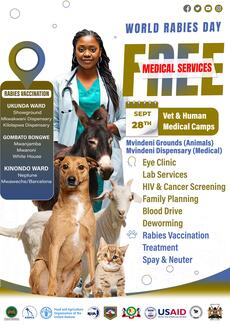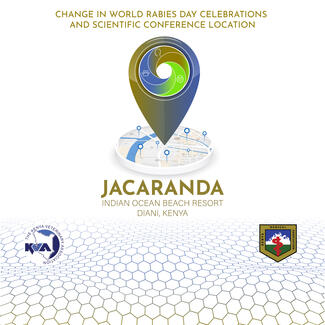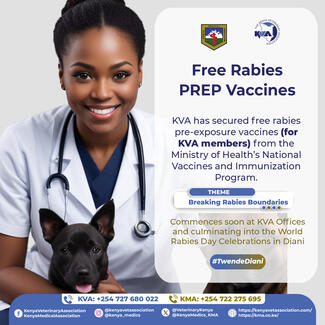
18th WORLD RABIES DAY CELEBRATIONS
Theme: Breaking Rabies Boundaries
Subtheme: Showcasing One Health in Action Towards End Rabies in Kenya
Held Jointly by The Kenya Veterinary Association (KVA) and the Kenya Medical Association (KMA)
Main Activity dates: 26th to 28th September 2024
Scientific conference: 26- 27 September 2024 (Jacaranda Indian Ocean Beach Resort, Diani)
Human and Animal Medical Camps: 28th September 2024,
Ukunda Ward _ Mvindeni Grounds (Veterinary Clinic), Mvindeni Dispensary (Human Clinic), ShowGround, Mkwakwani Dispensary, Kilolapwa Dispensary).
Gombato Bongwe - Mwanjamba, Mwaroni, White House
Kinondo Ward - Neptune, Mwaweche/Barcelona
Pre-event community Engagement: 23rd-28th September.
EVENT BACKGROUND
WRD 2024: Breaking Rabies Boundaries
This year (2024) the celebrations in Kenya will be jointly hosted by the Kenya Veterinary Association and the Kenya Medical Association and bringing together other partners including the Ministry of Health, Ministry of Agriculture & Livestock Development, the County Government of Kwale, FAO, USAID, National Vaccines and Immunization Program, Clinton Health Access Initiative, Government parastatals, pharmaceutical companies, hospitals among others.
This collaboration is envisioned to augment the existing advocacy efforts and the fight against Rabies while adopting the One Health Approach. Leveraging on this year’s theme “Breaking Rabies Boundaries”, the two organizations aim to consolidate one health resources and efforts to support the government’s efforts to eliminate rabies by 2030 as outlined in the National Rabies Elimination Strategy for Kenya which aims to eliminate human dog-mediated rabies by 2030.
The Theme “Breaking Rabies Boundaries” aims to highlight not only the obstacles within our control such as lack of collaborations between different stakeholders, weak legal frameworks and one health concept implementation but also those related to the transboundary nature of rabies.
Our sub theme for this year’s event will be: “Showcasing One Health in Action Towards End Rabies in Kenya” and the following will be our main activities; -
- Joint Scientific Conference & Exhibition where we discuss new findings and share knowledge related to the theme. Partners get the opportunity to display, make presentations on their activities and innovative ideas/products they offer.
- Joint Medical and Veterinary Camps - we will have veterinary and medical camps focused on health promotion, prevention and treatment around Rabies.
- Veterinary surgeons will offer dog and cat spay/ neuter, treatments and rabies vaccination for dogs, cats and donkeys.
- Medical doctors/practitioners will offer a medical camp, administer PREP vaccinations to the most vulnerable, deworm children and educate people on post exposure prophylaxis for rabies
- Stakeholders in both industries will meet and engage in educating the public on the role of healthcare professionals in society. Partners will get the opportunity to engage the public, donate their products for use as free samples, and issue relevant marketing materials to their targeted audience.
- Community Engagement activities including: -
- Rabies talks to schools
- Sporting activities and games to create rabies awareness
- Student competitions
- Media events to promote the theme and inform the public on the key roles played by two professionals in safeguarding human health and wellbeing.
GOALS AND OBJECTIVES
Goal: The goal of 2024 KVA-KMA WRD is to bring together at one health stakeholders including quadripartite members, AU bodies, government agencies and health professionals to chart ways to strengthen strategies to eliminate rabies and to create awareness among the public in with a view of bringing an end to human deaths attributed to rabies and other zoonotic diseases.
Objectives:
- To hold a two-day participatory scientific conference and exhibition bringing together at least 500 One Health delegates and 50 exhibitors.
- To hold a medical camp targeting 200 children for deworming and 400 people for routine medical procedures.
- To hold a veterinary camp targeting at least 500 dogs and 200 cats for vaccinations, and 100 dogs and cats for spay/neuter.
- To hold events and competitions targeting different population segments to create awareness among members of the public on Rabies and other zoonotic diseases
- To offer a marketing opportunity to our partners, to display, broadcast, and present their products and services with relevance to rabies elimination.
- To engage in social and media events that will promote the rabies elimination message.
EXPECTED RESULTS
Broadly, we expect to:
- Present a united front to the public, in order to showcase the benefits of working together. Further, we shall highlight the role of the industry and partner organizations in assuring the health of both animals and humans, by facilitating safe spaces for enhancing Human health, food safety and security, promoting safe world trade in animals and animal products thus ultimately protecting public health.
- Raise public awareness on Rabies and the role of health professionals, government and the community in ensuring the solutions, systems, means, measures and contributions control and ultimate elimination of the disease
- Build satisfactory partner engagements, collaborations and teamwork to enhance investments in the medical profession and associated industry players.
About the Organizers
The Kenya Veterinary Association is the sole professional membership organization of Veterinary Surgeons in Kenya. The association was founded in 1966 and registered in1967 under the Societies Act, Cap 108 of the Laws of Kenya and is affiliated to the World Veterinary Association, the Commonwealth Veterinary Association, the Association of Professional Societies in East Africa and the Kenya Healthcare Federation. Our primary mandate is promotion of welfare and economic development of the members. While the overarching aim is safeguarding the health and welfare of animals to assure public health and the growth and development of the animal resource industry and linked enterprises.
As part of its mandate in promoting science and safeguarding public health, KVA organizes events including scientific conferences, exhibitions, veterinary field days and other community engagement activities. KVA holds these events together with other partners to synergize efforts and maximize the outcomes.
The Kenya Medical Association is the umbrella professional association for doctors in Kenya. Founded in 1968, KMA has a twin mandate, to champion for the welfare of doctors and advocate for the highest standard of quality healthcare. Over the years, the Association has gained and held its position as a high-profile player and partner in many sectors of national development, at the policy level as well as in operation of services directly and indirectly related to health.
As a thought leader, KMA has largely focused on policy advocacy for quality healthcare, having contributed towards National Health Policies and the shaping of the standards of healthcare practice.
Through its thematic committees and strategic partnerships, KMA runs advocacy, community outreach and capacity building of the doctor’s fraternity in the areas of Public Health, Managed Healthcare, HIV and TB, Sexual and Reproductive Health and Human Rights, among others.
This year, the two associations are proud to jointly host the World Rabies Day Celebrations together with the with a view of demonstrating the One Health Approach in Kenya.
One Health Approach
The One Health approach is an integrative strategy that acknowledges the interconnectedness of human, animal, and environmental health. By fostering collaboration among veterinarians, medics, and other health professionals, this approach aims to address complex health issues that arise at the interface of these domains. It’s with this understanding that the Quadripartite organizations (FAO, UNEP, WHO and WOAH)) launched the One Health Joint Plan of Action (2022-2026). This plan aims to ‘prevent future pandemics and promote health sustainably through the One Health Approach.’
In Kenya, the One Health approach offers several significant benefits:
- Enhanced Disease Surveillance and Control: Collaborative efforts between vets and medics improve the detection, monitoring, and management of zoonotic diseases (diseases that can be transmitted from animals to humans), such as rabies, Rift Valley fever, and brucellosis. This leads to quicker response times and more effective containment of outbreaks.
- Improved Public Health Outcomes: By addressing the health of animals and the environment, the One Health approach contributes to better human health. For instance, controlling livestock diseases reduces the risk of foodborne illnesses and improves food safety and security.
- Integrated Research and Data Sharing: Joint research initiatives between veterinary and medical professionals lead to a more comprehensive understanding of disease dynamics. Shared data and knowledge enhance the ability to predict and prevent health crises.
- Cost-Effective Health Interventions: Coordinated efforts and resource sharing between vets and medics can reduce the duplication of efforts and optimize the use of limited resources, making health interventions more cost-effective.
- Capacity Building and Training: The One Health approach fosters interdisciplinary training and capacity building, equipping health professionals with a broader skill set to tackle complex health challenges.
- Environmental Health: By considering the impact of environmental factors on health, the One Health approach promotes sustainable practices that protect ecosystems and biodiversity, which are crucial for long-term health.
- Policy Development and Implementation: Collaborative efforts inform policy development and implementation, ensuring that health regulations are comprehensive and consider the interdependence of human, animal, and environmental health.
In Kenya, the integration of veterinary and medical expertise through the One Health approach is particularly crucial due to the high prevalence of zoonotic diseases and the close interaction between humans, livestock, and wildlife. This collaborative model leads to more resilient health systems, ultimately improving the well-being of communities and ecosystems. Its with this view that the two associations are partnering to mark this year’s World Rabies Day Celebrations.
Rabies
Rabies is a neglected Zoonotic disease which is almost invariably fatal in humans, livestock and other mammals. Globally 5.5 billion people are at risk of rabies, with the disease being responsible for up to 60,000 deaths per year, 95% of them being in Africa and Asia. Around half of those who die are children. The disease is preventable if adequate host susceptibility is reduced through vaccination. Children are particularly vulnerable to rabid dogs. This major source of rabies can be avoided through pet vaccination, education and ensuring proper access to medical resources.
Rabies in Kenya
Kenya has a 100-year history of rabies with the first confirmed rabies case recorded in 1912. Rabies is among the top 5 zoonotic diseases prioritized for control in Kenya with government focus highlighted by the Rabies Elimination Strategy. It is estimated that Rabies is the cause of up to 2,000 human deaths in Kenya, underscoring the need for urgent intervention.
In Kenya, as with other East African countries, rabies cycles are maintained by domestic dogs with no documented evidence that wildlife maintain rabies virus. Domestic dogs transmit at least 98% of human rabies in Kenya hence sustained annual mass dog vaccination (at least 3 consecutive years) of greater than 70% of dog population can achieve elimination of the disease in domestic dogs, and subsequently in humans and other domestic animals
Fortunately, more than 80% of dogs in Kenya are owned and are accessible for parenteral vaccination. This can then be complemented by other forms of vaccinations to achieve better coverage.
In fact, rabies elimination through mass dog vaccination is a cost-effective strategy, saves lives and results in decline in the use of costly human post exposure prophylaxis (PEP)
Unfortunately, a poor surveillance system has emerged as a barrier towards efforts to eliminate rabies. This is marked by under-reporting hindering efforts to better understand the landscape.
The Strategy for Elimination of Rabies 2014-2030
The Government of Kenya through the Zoonotic Disease Unit (ZDU), with support from development partners and other stakeholders in 2014 launched its “Strategic Plan for the Elimination of Human Rabies” which has completed its pilot phase and is now targeting to scale up country wide. Some of the strategies identified in tackling rabies include:
- Strengthening Surveillance and response to outbreaks.
- Elimination of rabies in dogs; Mass dog vaccination and dog population management- Rabies vaccinations and Dog population management.
- Conduct and promote operational research on Rabies
- Advocacy, communication and social mobilization
- Prompt provision of PEP
- Public Health Education and awareness creation on rabies
http://guidelines.health.go.ke:8000/media/Strategic_plan_for_elimination_of_Rabies.pdf
Sponsors and partners are welcome to support the scientific conference, medical and veterinary camps.
INQUIRIES
For any further inquiries, please contact us on:
The KVA Office on; Mobile: +254727680022
Email:[email protected]; [email protected]
The KMA Office on; Mobile; +254722275695
Email: [email protected]
The event Organizer on
Liz-+254722369743
Tony-+254757530509
Email: [email protected]; +254768825025
More details can be found at; https://www.kenyavetassociation.com/kva-kma-wrd/
Event images


